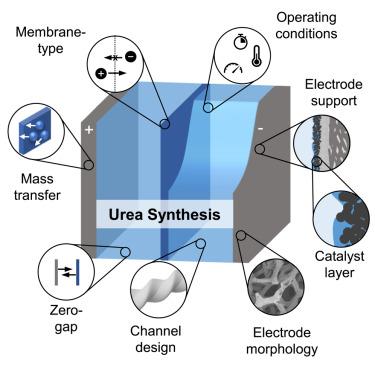Our official English website, www.x-mol.net, welcomes your
feedback! (Note: you will need to create a separate account there.)
Electrochemical urea synthesis
Joule ( IF 38.6 ) Pub Date : 2024-05-15 , DOI: 10.1016/j.joule.2024.04.004 Yannik Kohlhaas , Yannick S. Tschauder , Wenzel Plischka , Ulrich Simon , Rüdiger-A. Eichel , Matthias Wessling , Robert Keller
Joule ( IF 38.6 ) Pub Date : 2024-05-15 , DOI: 10.1016/j.joule.2024.04.004 Yannik Kohlhaas , Yannick S. Tschauder , Wenzel Plischka , Ulrich Simon , Rüdiger-A. Eichel , Matthias Wessling , Robert Keller

|
Enabling the electrification of the chemical industry is crucial for the sector’s transition toward zero emissions and a sustainable future. Approximately 2% of the globally used energy is dedicated to fertilizer production, including urea. The electrochemical synthesis of urea from a nitrogen source and based on renewable energy can contribute to reaching the ambitious goal of sustainable production with close to zero emissions. However, the current state of technology remains at a low readiness level and a small scale. The majority of studies in the field employ electrode surface areas in the order of 1 cm and achieve moderate current efficiencies of 50%. They are mostly operated in batch mode in H-cells, which are prone to mass transport limitations, leading to a restriction of the achievable current density. In this perspective, we analyze the main challenges regarding highly efficient and scalable reactors for continuous production. We identify knowledge gaps and potential pitfalls. Finally, we propose guidelines to rapidly bridge the gap between fundamental research and industrial application.
中文翻译:

电化学尿素合成
实现化学工业的电气化对于该行业向零排放和可持续未来的过渡至关重要。全球使用的能源中约 2% 用于化肥生产,包括尿素。利用氮源和可再生能源电化学合成尿素有助于实现接近零排放的可持续生产的宏伟目标。然而,目前的技术状态仍然处于低准备水平和小规模。该领域的大多数研究都采用 1 cm 数量级的电极表面积,并实现 50% 的中等电流效率。它们大多在 H 电池中以批量模式运行,这很容易受到质量传输的限制,从而导致可实现的电流密度受到限制。从这个角度来看,我们分析了用于连续生产的高效和可扩展反应器的主要挑战。我们确定知识差距和潜在陷阱。最后,我们提出了快速弥合基础研究和工业应用之间差距的指南。
更新日期:2024-05-15
中文翻译:

电化学尿素合成
实现化学工业的电气化对于该行业向零排放和可持续未来的过渡至关重要。全球使用的能源中约 2% 用于化肥生产,包括尿素。利用氮源和可再生能源电化学合成尿素有助于实现接近零排放的可持续生产的宏伟目标。然而,目前的技术状态仍然处于低准备水平和小规模。该领域的大多数研究都采用 1 cm 数量级的电极表面积,并实现 50% 的中等电流效率。它们大多在 H 电池中以批量模式运行,这很容易受到质量传输的限制,从而导致可实现的电流密度受到限制。从这个角度来看,我们分析了用于连续生产的高效和可扩展反应器的主要挑战。我们确定知识差距和潜在陷阱。最后,我们提出了快速弥合基础研究和工业应用之间差距的指南。











































 京公网安备 11010802027423号
京公网安备 11010802027423号